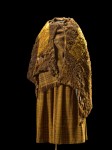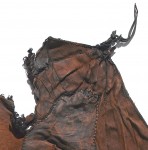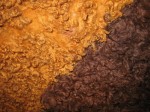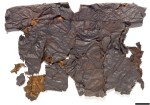 Danish researchers have developed a new protein analysis that can identify the animal source of fibers in the clothing of bog bodies. Before now, the skins and textiles worn by the bodies mummified by thousands of years in bogs were too degraded to be conclusively identified, even the very well-preserved examples.
Danish researchers have developed a new protein analysis that can identify the animal source of fibers in the clothing of bog bodies. Before now, the skins and textiles worn by the bodies mummified by thousands of years in bogs were too degraded to be conclusively identified, even the very well-preserved examples.
“With proteins, we could make a completely accurate species identification in 11 out of 12 samples and show that species identification that was carried out by microscopy on half of the samples was incorrect,” says lead-author Luise Brandt, who completed the research during her Ph.D. at the University of Copenhagen, but is now based at the University of Aarhus, Denmark.
The new technique can for the first time help archaeologists to differentiate between goats or sheeps wool, for example, which would otherwise be difficult to do when studying hairs that had spent 2000 years in a bog, says Brandt. […]
According to Brandt, her method should help to identify how people selected the material from which to make their clothes, which may give an insight into the resources available at the time in that society.
“It’s important to know what kind of material you have chosen for what [purpose], and there were various skins that were particularly useful for different functions. It tells us whether they kept or hunted the animals at that time, and beyond the practical aspects, the choice of material also reflects their tastes, or a desire to send a certain signal through what they wore,” says Brandt.
 Brandt previously tried to use DNA analysis to identify the material, but found that testable DNA did not typically survive after 2,000 years in a bog. The environment is so acidic that DNA strands degrade too much to be recovered. Proteins, on the other hand, were extraordinarily hardy, survived 10 times longer than DNA. Since the amino acids that make up proteins vary by animal species, protein extracted from ancient wool or leather can identify which animal the material came from.
Brandt previously tried to use DNA analysis to identify the material, but found that testable DNA did not typically survive after 2,000 years in a bog. The environment is so acidic that DNA strands degrade too much to be recovered. Proteins, on the other hand, were extraordinarily hardy, survived 10 times longer than DNA. Since the amino acids that make up proteins vary by animal species, protein extracted from ancient wool or leather can identify which animal the material came from.
 Brandt’s study took 12 samples from 10 cloaks and one tunic (two samples were taken from one cloak because the two sections were different colors) of bog bodies in the Danish National Museum. All of the bodies were found on the peninsula of Jutland and date to around 2000 years ago. They include Huldremose Woman, who was discovered wearing an exceptionally well-preserved outfit of a skirt, scarf and two cloaks. Brandt was able to identify the animal source in 11 of the 12 samples: two cow, three goat, six sheep. The 12th sample was inconclusive because it could only be narrowed down to sheep or goat. The protein that distinguishes between the two did not survive.
Brandt’s study took 12 samples from 10 cloaks and one tunic (two samples were taken from one cloak because the two sections were different colors) of bog bodies in the Danish National Museum. All of the bodies were found on the peninsula of Jutland and date to around 2000 years ago. They include Huldremose Woman, who was discovered wearing an exceptionally well-preserved outfit of a skirt, scarf and two cloaks. Brandt was able to identify the animal source in 11 of the 12 samples: two cow, three goat, six sheep. The 12th sample was inconclusive because it could only be narrowed down to sheep or goat. The protein that distinguishes between the two did not survive.
 The study indicates that the primary sources of materials for bog body garments were domesticated animals, not the skins of wild animals slain in the hunt, correcting a misconception about Iron Age Germanic peoples that has lingered since Tacitus who wrote in Germania that they “wear the skins of wild beasts.”
The study indicates that the primary sources of materials for bog body garments were domesticated animals, not the skins of wild animals slain in the hunt, correcting a misconception about Iron Age Germanic peoples that has lingered since Tacitus who wrote in Germania that they “wear the skins of wild beasts.”
 The protein analysis also revealed that the tunic belonging to a man found in Møgel bog near Jelling was made out of calf leather. Not only could the test distinguish between adult cow and baby, but it could narrow down the age of the calf from the last month of gestation through the first three months after birth. The key marker was hemoglobin, the protein found in red blood cells. The type of hemoglobin found in the tunic is produced only in the last month of pregnancy through the first three months after which it is replaced by another type.
The protein analysis also revealed that the tunic belonging to a man found in Møgel bog near Jelling was made out of calf leather. Not only could the test distinguish between adult cow and baby, but it could narrow down the age of the calf from the last month of gestation through the first three months after birth. The key marker was hemoglobin, the protein found in red blood cells. The type of hemoglobin found in the tunic is produced only in the last month of pregnancy through the first three months after which it is replaced by another type.
 This discovery suggests that the skins of domesticated animals may have been as important to Iron Age Danes as the meat and dairy they produced.
This discovery suggests that the skins of domesticated animals may have been as important to Iron Age Danes as the meat and dairy they produced.
“I think that the smoking gun was the haemoglobin. We can see that they went to great lengths to make the garments and choose the right skin,” says Brandt.
“But now we can see that they used calfskin for the tunic, which could suggest that the skin was a really important part of why they slaughtered young animals and that it was an important product,” says Brandt.